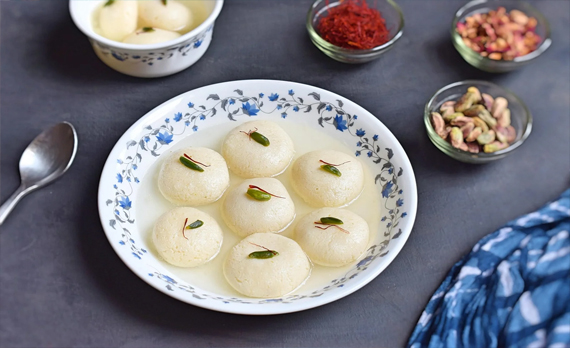The Rasgulla Recipe
Rasgulla, or “Roshogolla,” is a beloved Indian sweet that holds a special place in the hearts of people, particularly in Bengal, Odisha, and various parts of India. Made from fresh chhena (a type of paneer), the soft, spongy texture and sweet syrupy flavor make it one of the most iconic Indian sweets. Whether enjoyed during festivals, weddings, or casual family gatherings, Rasgulla represents a true piece of India’s rich culinary heritage. This article will delve deeply into the history, variations, and step-by-step preparation of Rasgulla, so you can recreate this delightful treat in your kitchen.
Table of Contents
- The History of Rasgulla
- Ingredients for Rasgulla
- Step-by-Step Rasgulla Recipe
- Making the Chhena (Paneer)
- Preparing the Dough for Rasgulla
- Boiling Rasgullas in Sugar Syrup
- Final Touches
- Tips for Perfect Rasgulla
- Common Mistakes to Avoid
- Variations of Rasgulla
- Orange-flavored Rasgulla
- Chocolate Rasgulla
- Sandesh (Chhena-based delicacies)
- Cultural Significance and Traditions
- Serving Suggestions and Storage
- Conclusion

1. The History of Rasgulla
Rasgulla’s origins have been a matter of debate for centuries, with claims from both West Bengal and Odisha. Each region takes pride in the sweet’s invention, and both have different legends and stories attached to it.
Bengal’s Claim
One widely accepted story is that Rasgulla was created by the Bengali sweet maker, Nobin Chandra Das, in the 19th century. He is said to have invented Rasgulla in Kolkata (then Calcutta) around 1868. Before his invention, Bengali sweets were largely limited to milk-based treats like Kheer and Sandesh. Nobin Chandra Das, an innovator, experimented with chhena (curdled milk) and created the soft, spongy sweet that would eventually be known as Rasgulla.
Odisha’s Claim
On the other hand, Odisha also lays claim to Rasgulla, with historical records suggesting that the sweet existed in the region long before the 19th century. According to legend, Rasgulla was offered to Goddess Jagannath in Puri as part of the Chhappana Bhog (a set of 56 food offerings). The Odiya version is believed to have been cooked in a special ‘rose-water’ syrup and was used in religious ceremonies.
In 2015, Rasgulla from West Bengal was granted the Geographical Indication (GI) tag, while Odisha filed an appeal, claiming the sweet as part of their heritage. Regardless of its origin, Rasgulla is now an iconic sweet across the Indian subcontinent.
2. Ingredients for Rasgulla
To make Rasgulla at home, the recipe is surprisingly simple, requiring only a few ingredients that are easily available. However, the technique and proportions must be precise to achieve the perfect texture.
Essential Ingredients:
- Whole Milk (Full-fat) – 1 liter
- Lemon Juice or Vinegar – 1 to 2 tbsp (to curdle the milk)
- Water – 1.5 cups
- Sugar – 1.5 to 2 cups (adjust to your sweetness preference)
- Cardamom (optional) – 2 to 3 pods, crushed
- Rose Water or Kewra Water (optional) – a few drops for fragrance
Equipment:
- Heavy-bottomed pan for boiling milk
- Muslin cloth or cheesecloth for straining the curdled milk
- Large saucepan for boiling Rasgullas in sugar syrup
- Slotted spoon for transferring the Rasgullas
- Bowl for kneading the dough
3. Step-by-Step Rasgulla Recipe
Here’s how you can make Rasgullas at home, with a detailed step-by-step guide.
A. Making the Chhena (Paneer)
The key to perfect Rasgullas lies in making the chhena (also known as paneer). This is the base of Rasgullas, and the texture must be right – neither too dry nor too wet.
1. Boil the Milk
Start by boiling 1 liter of full-fat milk in a heavy-bottomed pan. Stir the milk occasionally to prevent it from scorching at the bottom. Once the milk begins to boil, reduce the heat to low.
2. Curdle the Milk
Now, slowly add 1-2 tbsp of lemon juice or vinegar to the milk, stirring gently. The milk will start to curdle, and the curds (solid part) will separate from the whey (liquid part). If the milk does not curdle completely, add a little more lemon juice or vinegar. The goal is to achieve a clean separation between the curds and whey.
3. Strain the Curdled Milk
Once the milk has completely curdled, turn off the heat and allow it to sit for 5 minutes. Then, line a colander with a muslin or cheesecloth and pour the curdled milk into it. Let the whey drain out. You can save the whey for other recipes like soups or gravies.
4. Rinse the Chhena
After draining, rinse the chhena under cold water to remove any residual lemon or vinegar taste. This will also help in cooling it down. Gather the corners of the cloth and twist to remove any excess water. Hang the cloth for about 30 minutes to allow more liquid to drain out.
At this point, you should have fresh, moist chhena ready for use in your Rasgulla dough.
B. Preparing the Dough for Rasgulla
1. Knead the Chhena
Once the chhena has been drained and cooled down, transfer it to a clean surface or bowl. Start kneading the chhena with your palms for about 5 to 7 minutes. The goal is to make the chhena smooth, soft, and free of lumps. Kneading properly is crucial for achieving a smooth dough that will yield soft, spongy Rasgullas.
If the dough feels dry or crumbly, you can add a tablespoon or two of milk to moisten it.
2. Make Small Balls
Divide the dough into small portions, and roll them into smooth balls. Be sure there are no cracks on the surface of each ball, as cracks can cause the Rasgullas to break apart during boiling. The size of the balls can vary, but they should ideally be about 1-inch in diameter.
C. Boiling Rasgullas in Sugar Syrup
The next critical step is cooking the Rasgullas in sugar syrup. The sugar syrup should be just the right consistency—neither too thin nor too thick—so that the Rasgullas can absorb the syrup without becoming overly sweet.
1. Prepare the Sugar Syrup
In a large saucepan, add 1.5 to 2 cups of sugar and 1.5 cups of water. Bring it to a boil while stirring to dissolve the sugar. You can add a few crushed cardamom pods or a drop of rose water or kewra water for fragrance at this point. Once the syrup starts to boil, lower the heat.
2. Cook the Rasgullas
Now, gently drop the prepared Rasgulla balls into the boiling sugar syrup. The syrup should be simmering, not violently boiling. Cover the pan with a lid and cook the Rasgullas on medium heat for 15-20 minutes. The balls will double in size as they cook, so make sure there’s enough space in the syrup for them to expand.
3. Check the Doneness
After about 15 minutes, you can check the Rasgullas by dropping one in a glass of cold water. If it floats and doesn’t break apart, they are ready. If they sink to the bottom, they need more time to cook.
4. Let the Rasgullas Cool
Once cooked, remove the Rasgullas from the syrup and let them cool down. They should be soft and spongy, having absorbed some of the syrup while still maintaining their shape.
4. Tips for Perfect Rasgulla
- Use Full-Fat Milk: For the best texture, always use full-fat milk. Skim milk will not yield the same results.
- Knead Well: Kneading is crucial. The chhena must be kneaded until it becomes smooth and soft. Avoid over-kneading, as this will make the dough tough.
- Syrup Consistency: The sugar syrup should be light and watery, not too thick. A syrup that’s too thick can make the Rasgullas dense and hard.
- Cook at Low Heat: Rasgullas should be cooked at a medium-low simmer, not high heat. High heat can cause them to crack and lose their shape.
5. Common Mistakes to Avoid
- Not Properly Kneading the Chhena: Lumpy dough will not form smooth Rasgullas. Knead the dough well to ensure softness.
- Boiling on High Heat: High heat can cause Rasgullas to break. Always cook them at medium to low heat.
- Using Too Little Sugar Syrup: The Rasgullas need to absorb the syrup to become soft. Make sure there is enough syrup for them to expand.
- Skipping the Cooling Step: Let the Rasgullas cool in the syrup to retain their soft, spongy texture.
6. Variations of Rasgulla
Orange-flavored Rasgulla
To add a citrusy twist, you can flavor your sugar syrup with orange zest or juice. The bright flavor complements the mild sweetness of the Rasgullas.
Chocolate Rasgulla
For a more decadent version, dip the Rasgullas in melted chocolate after they have been cooked in sugar syrup. This fusion adds a rich layer of chocolate while maintaining the original Rasgulla softness.
Sandesh
Sandesh is another Bengali sweet made from chhena. You can make flavored Sandesh by adding saffron, rose water, or cardamom to the chhena before shaping it into decorative pieces.
7. Cultural Significance and Traditions
Rasgulla holds a place of honor in Bengali cuisine, often being served at weddings, religious occasions, and festivals. In Bengal, the sweet is closely tied to celebrations of Durga Puja, a festival dedicated to the goddess Durga. It’s also associated with the famous Jagannath Temple in Puri, Odisha, where Rasgullas are offered as part of the religious rituals.
In the Bengali tradition, Rasgulla is often part of the ‘Bhog’ (ritual offering) made to deities. During the festival of Poila Boishakh (Bengali New Year), it’s common to serve a variety of sweets, with Rasgulla taking center stage.
8. Serving Suggestions and Storage
Rasgullas are typically served chilled. They can be stored in the refrigerator for up to a week. Ensure they are submerged in the sugar syrup to maintain their moisture and softness. If you’re storing them in a container, make sure it’s airtight.
9. Conclusion
Rasgulla is not just a sweet; it’s a piece of cultural heritage. Whether you’re making it for a special occasion or simply to enjoy a delicious treat, this soft, syrup-soaked sweet will surely leave you with a smile. With the right ingredients, technique, and patience, you can recreate this iconic dessert in your kitchen. Happy cooking!




